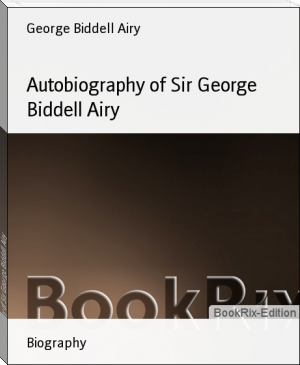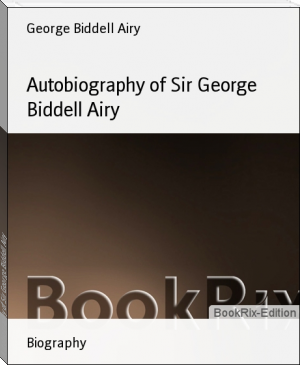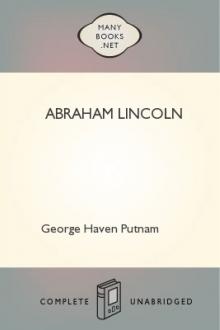Autobiography of Sir George Biddell Airy by George Biddell Airy (e reader for manga .TXT) 📕

- Author: George Biddell Airy
Book online «Autobiography of Sir George Biddell Airy by George Biddell Airy (e reader for manga .TXT) 📕». Author George Biddell Airy
AUTOBIOGRAPHY
OF
SIR GEORGE BIDDELL AIRY, K.C.B.,
M.A., LL.D., D.C.L., F.R.S., F.R.A.S.,
HONORARY FELLOW OF TRINITY COLLEGE, CAMBRIDGE,
ASTRONOMER ROYAL FROM 1836 TO 1881.
EDITED BY
WILFRID AIRY, B.A., M.Inst.C.E.
1896
PREFACE.
The life of Airy was essentially that of a hard-working, business man, and differed from that of other hard-working people only in the quality and variety of his work. It was not an exciting life, but it was full of interest, and his work brought him into close relations with many scientific men, and with many men high in the State. His real business life commenced after he became Astronomer Royal, and from that time forward, during the 46 years that he remained in office, he was so entirely wrapped up in the duties of his post that the history of the Observatory is the history of his life. For writing his business life there is abundant material, for he preserved all his correspondence, and the chief sources of information are as follows:
(1) His Autobiography.
(2) His Annual Reports to the Board of Visitors.
(3) His printed Papers entitled "Papers by G.B. Airy."
(4) His miscellaneous private correspondence.
(5) His letters to his wife.
(6) His business correspondence.
(1) His Autobiography, after the time that he became Astronomer Royal, is, as might be expected, mainly a record of the scientific work carried on at the Greenwich Observatory: but by no means exclusively so. About the time when he took charge of the Observatory there was an immense development of astronomical enterprise: observatories were springing up in all directions, and the Astronomer Royal was expected to advise upon all of the British and Colonial Observatories. It was necessary also for him to keep in touch with the Continental Observatories and their work, and this he did very diligently and successfully, both by correspondence and personal intercourse with the foreign astronomers. There was also much work on important subjects more or less connected with his official duties--such as geodetical survey work, the establishment of time-balls at different places, longitude determinations, observation of eclipses, and the determination of the density of the Earth. Lastly, there was a great deal of time and work given to questions not very immediately connected with his office, but on which the Government asked his assistance in the capacity of general scientific adviser: such were the Correction of the Compass in iron ships, the Railway Gauge Commission, the Commission for the Restoration of the Standards of Length and Weight, the Maine Boundary, Lighthouses, the Westminster Clock, the London University, and many other questions.
Besides those above-mentioned there were a great many subjects which he took up out of sheer interest in the investigations. For it may fairly be said that every subject of a distinctly practical nature, which could be advanced by mathematical knowledge, had an interest for him: and his incessant industry enabled him to find time for many of them. Amongst such subjects were Tides and Tidal Observations, Clockwork, and the Strains in Beams and Bridges. A certain portion of his time was also given to Lectures, generally on current astronomical questions, for he held it as his duty to popularize the science as far as lay in his power. And he attended the meetings of the Royal Astronomical Society with great regularity, and took a very active part in the discussions and business of the Society. He also did much work for the Royal Society, and (up to a certain date) for the British Association.
All of the foregoing matters are recorded pretty fully in his Autobiography up to the year 1861. After that date the Autobiography is given in a much more abbreviated form, and might rather be regarded as a collection of notes for his Biography. His private history is given very fully for the first part of his life, but is very lightly touched upon during his residence at Greenwich. A great part of the Autobiography is in a somewhat disjointed state, and appears to have been formed by extracts from a number of different sources, such as Official Journals, Official Correspondence, and Reports. In editing the Autobiography it has been thought advisable to omit a large number of short notes relating to the routine work of the Observatory, to technical and scientific correspondence, to Papers communicated to various Societies and official business connected with them, and to miscellaneous matters of minor importance. These in the aggregate occupied a great deal of time and attention. But, from their detached nature, they would have but little general interest. At various places will be found short Memoirs and other matter by the Editor.
(2) All of his Annual Reports to the Board of Visitors are attached to his Autobiography and were evidently intended to be read with it and to form part of it. These Reports are so carefully compiled and are so copious that they form a very complete history of the Greenwich Observatory and of the work carried on there during the time that he was Astronomer Royal. The first Report contained only four pages, but with the constantly increasing amount and range of work the Reports constantly increased in volume till the later Reports contained 21 pages. Extracts from these Reports relating to matters of novelty and importance, and illustrating the principles which guided him in his conduct of the Observatory, have been incorporated with the Autobiography.
(3) The printed "Papers by G.B. Airy" are bound in 14 large quarto volumes. There are 518 of these Papers, on a great variety of subjects: a list of them is appended to this history, as also is a list of the books that he wrote, and one or two of the Papers which were separately printed. They form a very important part of his life's work, and are frequently referred to in the present history. They are almost all to be found in the Transactions of Societies or in newspapers, and extend over a period of 63 years (1822 to 1885). The progress made in certain branches of science during this long period can very fairly be traced by these Papers.
(4) His private correspondence was large, and like his other papers it was carefully arranged. No business letters of any kind are included under this head. In this correspondence letters are occasionally found either dealing with matters of importance or in some way characteristic, and these have been inserted in this biography. As already stated the Autobiography left by Airy is confined almost entirely to science and business, and touches very lightly on private matters or correspondence.
(5) The letters to his wife are very numerous. They were written during his occasional absences from home on business or for relaxation. On these occasions he rarely let a day pass without writing to his wife, and sometimes he wrote twice on the same day. They are full of energy and interest and many extracts from them are inserted in this history. A great deal of the personal history is taken from them.
(6) All correspondence in any way connected with business during the time that he was Astronomer Royal is to be found at the Royal Observatory. It is all bound and arranged in the most perfect order, and any letter throughout this time can be found with the greatest ease. It is very bulky, and much of it is, in a historical sense, very interesting. It was no doubt mainly from this correspondence that the Autobiography, which so far as related to the Greenwich part of it was almost entirely a business history, was compiled.
The history of the early part of his life was written in great detail and contained a large quantity of family matter which was evidently not intended for publication. This part of the Autobiography has been compressed. The history of the latter part of his life was not written by himself at all, and has been compiled from his Journal and other sources. In both these cases, and occasionally in short paragraphs throughout the narrative, it has been found convenient to write the history in the third person.
2, THE CIRCUS,
GREENWICH.
NOTE.
The Syndics of the Cambridge University Press desire to express their thanks to Messrs Macmillan & Co. for their courteous permission to use in this work the steel engraving of Sir George Biddell Airy published in Nature on October 31, 1878.
TABLE OF CONTENTS.
CHAPTER I.
Personal Sketch of George Biddell Airy
CHAPTER II.
From his birth to his taking his B.A. Degree at Cambridge
CHAPTER III.
At Trinity College, Cambridge, from his taking his B.A. Degree to his taking charge of the Cambridge Observatory as Plumian Professor
CHAPTER IV.
At Cambridge Observatory, from his taking charge of the Cambridge Observatory to his residence at Greenwich Observatory as Astronomer Royal
CHAPTER V.
At Greenwich Observatory, 1836-1846





Comments (0)